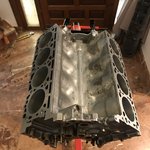Having just been rebuilding my replacement S500 m119 motor I wanted to add some tips and insight for others in the future.
Unfortunately I do not have time for a "How To" - these are more of pointers and experience that will be of use for anyone taking this job on or considering what is involved. It may encompass alot of areas but bear with me it will all be relevant.
Firstly, why take the heads off?
I took them off this motor as when I was in the middle of replacing the valve stem oil seals in situ I encountered problems with valves leaking so much air I could not complete the work. The motor was already out and on a trolley so best time to get stuck now than encounter any issues AFTER the used motor would be installed in the car.
Head gasket failure on a m119 is rare from what I have read and dont take this job lightly unless you are experienced level DIYr and dont plan on needing the car any time soon! There are many items which should be/ must be replaced when completing this task. Such as;
Next will be tips on the heads themselves once removed.
Unfortunately I do not have time for a "How To" - these are more of pointers and experience that will be of use for anyone taking this job on or considering what is involved. It may encompass alot of areas but bear with me it will all be relevant.
Firstly, why take the heads off?
I took them off this motor as when I was in the middle of replacing the valve stem oil seals in situ I encountered problems with valves leaking so much air I could not complete the work. The motor was already out and on a trolley so best time to get stuck now than encounter any issues AFTER the used motor would be installed in the car.
Head gasket failure on a m119 is rare from what I have read and dont take this job lightly unless you are experienced level DIYr and dont plan on needing the car any time soon! There are many items which should be/ must be replaced when completing this task. Such as;
- Timing chain, chain tensioner and all slide rails (left lower rail is only accessible by removal of the timing cover. Banana rail has a pin which allows it to be removed up and out with the timing cover on)
- Valve job
- 4x O ring seals behind the timing cover itself
- Radial oil seals in upper timing covers
- Cam magnet reseal or replacement (very common m119 oil leak)
- Ignition insulator cups (another m119 weak point)
- Crankshaft front and rear main oil seals
- Valve stem oil seals. Mine were hard as plastic and not making any sort of effective seal anymore. My experience is DO NOT attempt to replace valve stem oil seals on an m119 with the heads still on the block. Dont even think about trying it in the car at all since you will not be able to compress the valves. It is simply much, much too time consuming and taking the heads off and letting a machine shop do it is my preference.
- Head gaskets themselves obviously. They do degrade with age mine were delaminating and rusting when removed. Still serviceable but who knows for how long they are after all nearly 30 years old by now
- Oil separator valve and funnel
- Oiler tube seal rings and upgrade to metal version tubes if it doesn't already have it
- Intake manifold rubber gaskets and seal rings which can age harden and crack
- All PCV breather hoses, rubber tubes, and Tecalan (plastic) tubing
- Water pump & thermostat
- Consider late style belt tensioner upgrade (for early engines with manual tensioner)
- Oil pickup tube if timing cover comes off and the Oil Sender O ring.
- Suggest updated oil check valve also (for early engines)
Next will be tips on the heads themselves once removed.
Last edited:







